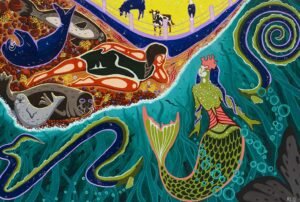
The Amazon rainforest is often referred to as the “lungs of the Earth.” One of the world’s most vital ecosystems, it’s facing a crisis due to deforestation and climate change. These threats jeopardize the livelihoods of Indigenous communities and the biodiversity the forest sustains.
In response to this urgent situation, a collaboration has been launched between Vivo—recognized as the most sustainable company in Brazil and Latin America—and various Indigenous communities and environmental organizations, including the Paiter Suruí community and the Amazon Environmental Research Institute (IPAM Amazônia). The campaign is called the “Amazon Desert Rally.”
Collaboration between Indigenous and Environmental Groups
The “Amazon Desert Rally” uses the hypothetical scenario of a desert car race to highlight the severe environmental degradation occurring in the Amazon Basin. A conceptual rally whose primary goal is to raise awareness, the campaign presents a dystopian vision of a future where the once powerful rivers of the Amazon have turned into dry riverbeds. In the campaign, rally drivers speed down vast tracks of dried riverbeds. The slogan “Don’t sponsor this race” warns this future will happen without immediate action to reduce human impact on vast ecosystems.
“Everyone loves sport and sport is the way we think we can get this message out to the people of the world about the huge environmental crisis we are facing in the Amazon region,” according to Paulo Moutinho, a senior researcher at IPAM Amazônia.
The Amazon Basin lost a staggering 120 trillion liters of water in 2023 alone.Collaboration between Vivo, Indigenous communities, and environmental organizations is important to the campaign’s impact. Vivo brings resources and visibility to the cause. The Indigenous communities, particularly the Paiter Suruí, bring invaluable local knowledge and a deep connection to the land, providing authenticity, urgency, and ensuring the campaign’s message is shaped by those who are directly affected.
According to Moutinho, “The Amazon Indigenous peoples, who are not only the guardians of the forest but also the rivers, played a pivotal role in the ‘Amazon Desert Rally.’ Their way of life is intricately linked to the rivers, which can only be sustained if the forest is preserved.”
Deforestation in the Amazon is primarily driven by illegal logging, agricultural expansion, and infrastructure development. This rampant deforestation is not only reducing the forest cover but also disrupting the water cycle. Trees play a crucial role by absorbing and releasing moisture into the atmosphere. But when these trees are removed, the water vapor entering the atmosphere decreases, leading to reduced rainfall and drying rivers.
The Amazon Basin lost a staggering 120 trillion liters of water in 2023 alone. Rivers that once teemed with life are now drying up, affecting the Indigenous peoples who depend on these water sources for fishing, transportation, and agriculture. The drying rivers are also exacerbating the problem of forest fires. In the Brazilian state of Roraima, for instance, the number of heat spots has increased dramatically, leading to more frequent and intense forest fires that destroy vegetation, wildlife, and homes while blanketing the region in thick smoke.
Climate change further compounds these problems by altering weather patterns and increasing the frequency and intensity of extreme weather events. The Amazon rainforest, which plays a crucial role in regulating the global climate by absorbing carbon dioxide, is itself becoming a victim of climate change. Rising temperatures and changing rainfall patterns make the forest more susceptible to droughts and fires, accelerating the cycle of destruction.
A deeper understanding of the climate’s interconnectedness helps to counteract greenwashing by promoting genuine, long-term changes.
If current trends continue, nearly half of the Amazon rainforest is projected to be degraded by 2050. The “Amazon Desert Rally” drives home the message that the Amazon’s fate is not sealed if action is taken now.
Greenwashing Concerns
Automotive companies have been accused of exaggerating their sustainability initiatives to appear environmentally friendly while continuing harmful practices. This is known as greenwashing: the practice of presenting misleading or exaggerated claims about the environmental benefits of a product or service, and it has become a significant issue in various industries, including race car driving.
Sign up for our free newsletters
Subscribe to NPQ's newsletters to have our top stories delivered directly to your inbox.
By signing up, you agree to our privacy policy and terms of use, and to receive messages from NPQ and our partners.
Paulo Moutinho addressed these concerns directly, noting that being aware of “greenwashing is super important. In the context of the Amazon Desert Rally campaign, we brought in scientific backing to ensure there were no doubts about the future projections, namely the drying up of the Amazon rivers.”
The “Amazon Desert Rally” also aims to engage the transportation sector in broader sustainability efforts. Moutinho emphasized that bringing the climate crisis into the racing world could lead to “more genuine efforts of sustainability and zero greenhouse gas emissions.” A deeper understanding of the climate’s interconnectedness helps to counteract greenwashing by promoting genuine, long-term changes in industry practices, such as transitioning to sustainable fuels and reducing overall emissions.
Environmental Impact of Race Car Driving
Reimagining racing could help curb climate change, considering its significant environmental impacts due to its high levels of emissions. The sport is known for its intense fuel consumption and carbon footprint.
The “Amazon Desert Rally” leverages the popularity of car racing to promote an energy transition within the transportation sector, using motorsports to draw attention to the critical climate issue.
Moutinho noted the potential for electric vehicles (EVs) in this context: “I know there are numerous electric car competitions already underway. This might be the future of the sport, just as it is for city cars and public transportation systems.”
“The campaign draws attention to the fact that rivers can die and water can run out, including water for human consumption.”
The project also incorporates educational components aimed at raising public awareness. Through media coverage, social media engagement, and partnerships with environmental organizations, the “Amazon Desert Rally” disseminates information about the environmental challenges and potential solutions. This educational outreach is crucial in building public support for the transition to sustainable transportation and broader environmental conservation efforts.
Campaign Milestones and Public Impact
Since its inception, the “Amazon Desert Rally” has achieved several notable milestones, including the successful collaboration between the Stock Car Pro Series and Indigenous groups, which has brought a diverse array of stakeholders together for a common cause. This partnership has amplified the voices of Indigenous peoples, who are on the frontline of the fight against climate change.
The campaign has also garnered extensive public attention. By framing the rally as a hypothetical yet plausible scenario, it’s captured the public’s imagination and driven home the message of environmental urgency.
Moreover, the campaign has raised awareness about the interconnectedness of various environmental issues within the Amazon River Basin, highlighting the links among deforestation, water scarcity, biodiversity loss, and climate change. This comprehensive approach has been crucial in educating the public about the multifaceted nature of environmental degradation and the need for integrated solutions.
As Moutinho explained, “The campaign draws attention to the fact that rivers can die and water can run out, including water for human consumption….We need to think about the products we buy and the preciousness of water,” he said. “Sport has the power to change minds and to raise awareness of the fragility of the world we live in.”












